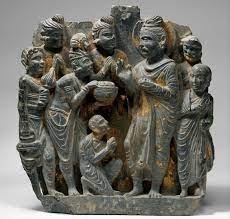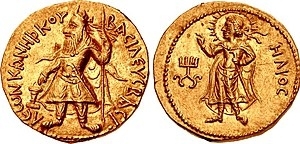Kushana Rule
Hello Aspirants,
In this article, we have covered the Kushanas rule which was prevalent in Northern India around 232 BC. Below the article you will also find the direct link to download the PDF of these notes. All the Best!!
Kushana Rule
The decline of the Mauryan empire began after Ashoka’s rule ended in 232 BC. The empire collapsed within 25 years. Simultaneously the area began to shrank and several powers both native and outsiders occupied the space.
Among the natives were Sungas, Kanvas and Satvahanas in eastern and Deccan India. During 200 BC, there started widespread contacts with Central Asia. As India didn’t saw any large empire of Mauryan scale for a long time, several of the dynasties from northwestern part started pushing. Some of the prominent were Sakas, Parthians etc. Kushans were one among them who came around 50 AD.
Background of Kushans
- Kushans succeeded the Parthian rulers.
- Yue-chi tribe was divided into five clans and they were one among them, also called as Tocharans.
- They were from steppes in north Central Asia and were nomadic.
- First, they occupy Bactria or north Afghanistan. Sakas were displaced there by them.
- Moving southwards gradually, they crossed the Hindu Kush and occupied Gandhara, and replaced Parthians and Greeks in those areas.
- The empire was vastly extending from Oxus and Khorasan in Central Asia to Ganga and Varanasi in Uttar Pradesh.
- Kushanas unified several parts of Central Asia, Iran, Entire Pak, and most part of Northern India bringing under one ruler.
Dynasties of Kushanas
There are 2 dynasties of the Kushan tribe that ruled India.
First:
- Founded by Kadphises, House of chiefs.
- Term: 28 years starting from 50 AD
- Two rulers Kadphises I (Kujul Kadphises) and II (Vema Kadphises), ruled under this dynasty.
- They both issued a large number of Coins. Kadphises I, minted a large number of copper coins in sync with Roman coins. Kadphises II issued gold money and also expanded the kingdom to the far east.
Second:
- Kanishka succeeded the House of Kadphises. Kanishka kings further expanded the kingdom over lower Indus basin and upper India. The authority was much higher over the Gangetic basin.
- The large number and purer gold coins were issued by them, found mainly in the west of Indus.
- Kanishka continued to rule the northwestern part until 230 AD. Several of his successor intermingled completely into India, and also acquired Indian names. Vasudeva was the last ruler of the dynasty.
Importance of the rule
Polity
- Kanishka was a very important ruler of the dynasty and was also referred to as Second Ashoka.
- He has two important achievements under him.
- The calendar started by him in 78 AD called as Saka Era, is used by the Government of India as its official calendar.
- Kushans rulers had two capitals: One at Peshawar in Pakistan, then called as Purushapura and other at Mathura.
- Native rulers were sidelined by either conquering or through imposing the rules. A feudatory type organization was developed.
- Titles like Kings of Kings were used to indicate the supremacy.
- Kushan kings called themselves Sons of god, hence the idea of divine origin gets strengthened which was already in use in India.
- Satrap system of government was introduced where the empire was divided into several satrapies and each was ruled by a satrap.
- Power was less centralized and a curious dual hereditary system was followed where father and son duo, ruled the same kingdom at the same time.
Art and Culture
- The large extent of rule, varying over five different countries, each having its unique art, culture and heritage provided opportunities to intermingle and process a new culture.
- Further enrichment of Buddhism. He was one of its greatest patrons and also convened the fourth Buddhist council in Kashmir. Mahayana doctrine of Buddhism was finalized there.
- Although influenced by Buddhist, several rulers also worshipped Vishnu. He patronized Sanskrit art and literature too.
- The court of Kanishka was the host of scholars like Parsva, Vasumitra, Asvaghosha, Nagarjuna, Charak and Mathara.
- Asvaghosha is the author of Buddhacharita and Saundarananda (famous Sanskrit poem)
- Famous Mathura school of art and architecture emerged and gained prominence during the Kushan rule. They also patronized the Gandhara school of art.
- Mathura school of art used red sandstone. It produced stone images of Buddha, Mahavira. However, it is famous for the headless erect statue of Kanishka.
- Kushans bought the long turbans and sherwanis to the Indian wearing culture. Pictures and terracotta figures of foreign horsemen wearing long coats can be seen. They also bought helmets, caps and boots to be used by warriors.
Trade and Technology
- Famous silk route originating in China was controlled by them. It passed through Iran and Western Asia and hence provided huge incomes to Kushans. They levied tolls on the route.
- A large number of coins were issued during their rule showing large trade.

- Kushans introduced a great cavalry and widescale use of horses in wars and trade. The use of reins and saddles were made common. Kushans were among the excellent horsemen.
- India also received a great deal of gold due to contacts from Central Asia. It came from the Altai mountains.
Decline:
Sassanian power rose in Iran during 350 AD. It supplanted the Kushans in Ian and West Indus area. However, their rule continued in parts of India for over a hundred years. The authority, however, declined completely with the emergence of Gupta rulers which ruled almost all over India.
However, it can be said that in the way these rulers got amalgamated in the country along with their culture and tradition, in no other period we can find such dissolution. The rulers left a great mark on Indian history with their art and heritage. Also, the gold coins are still being discovered and unearthed at several places.
Comments
Post a Comment